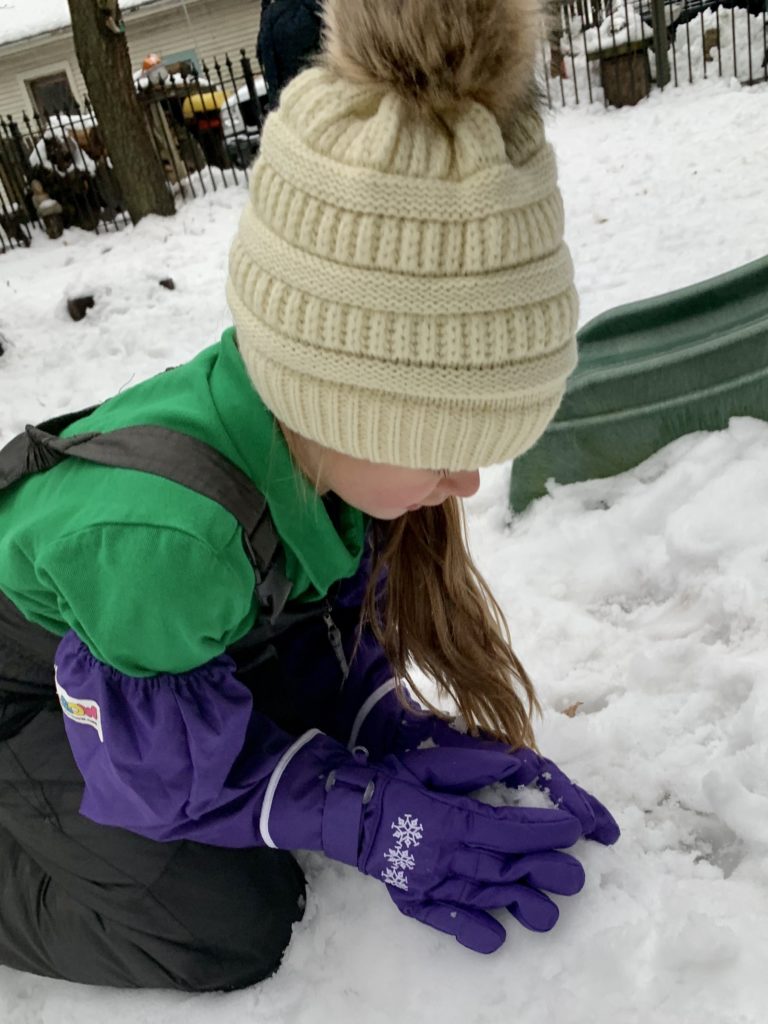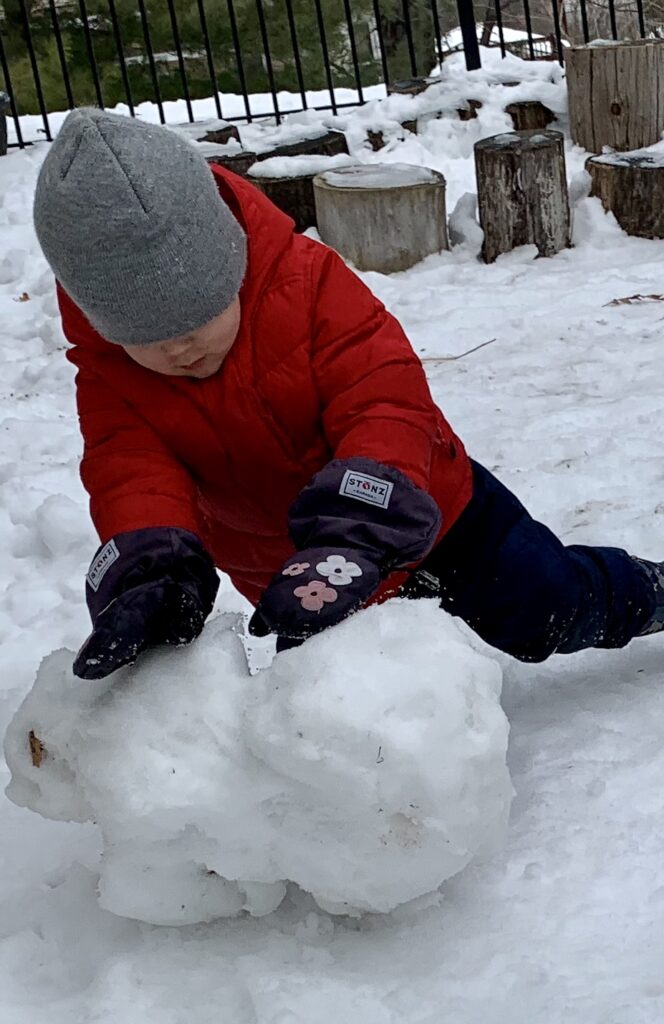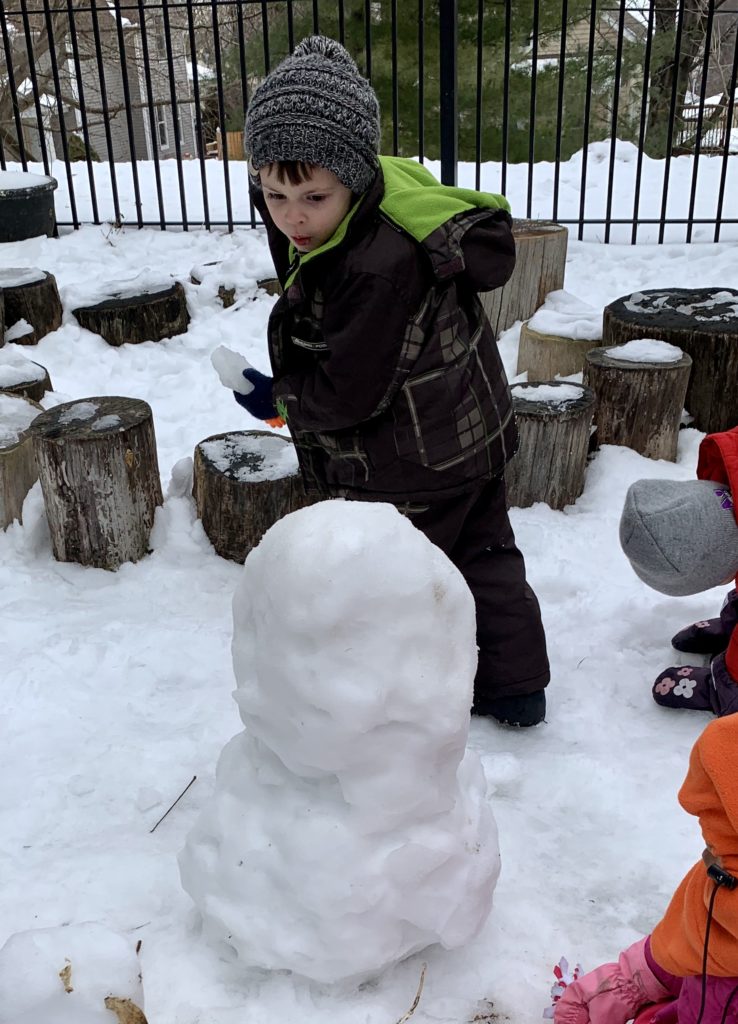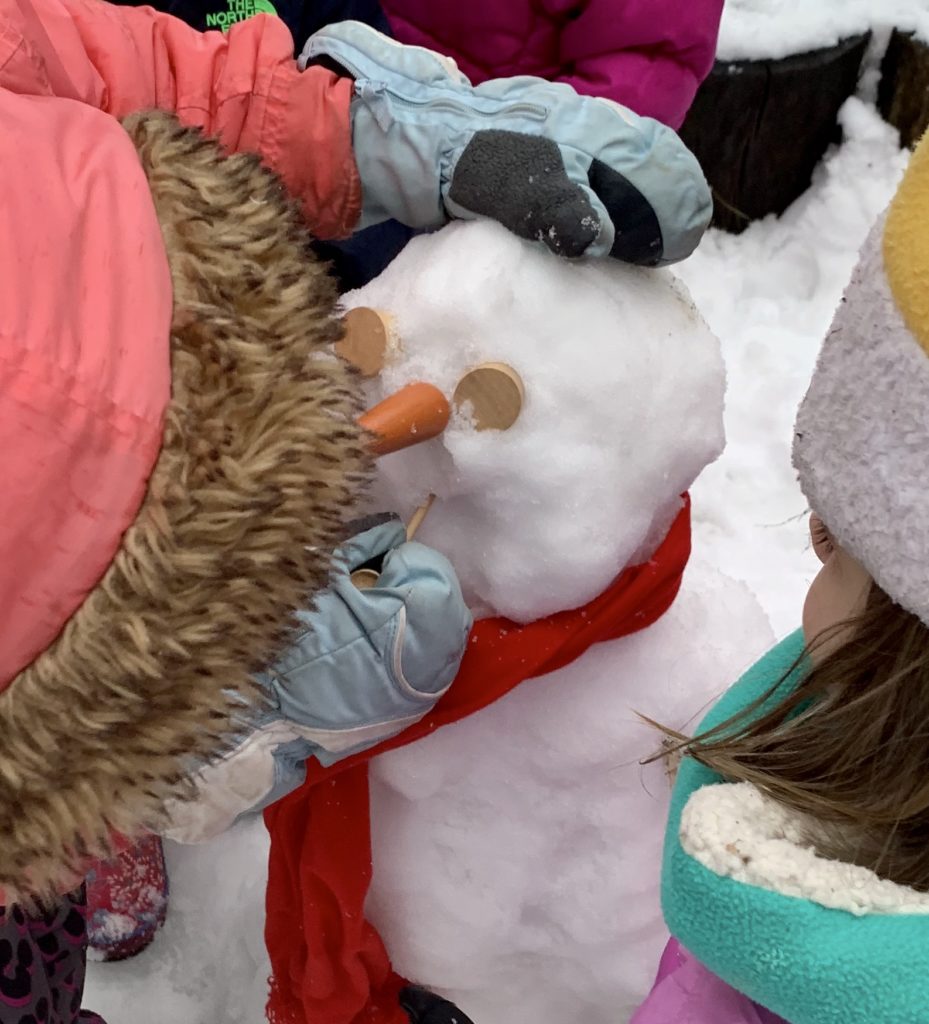Finding STEM on a Snowy Day

“Look, the snow packs! Let’s make some snow people!”
The sunshine and rising temperatures have transformed yesterday’s powdery snow into packable fun for an afternoon of playful math and science learning.
This is a great time to pull out your camera to document the many foundation-building moments that find their way into winter play.
This documentation allows us to review and reflect on the collaborations and investigations that can unfold on a snowy, sunlit January afternoon—and see how many early learning standards we’ve met through playful problem-solving.
“We need three giant snowballs!” yells Hudson. “One for the snowman’s head, one for his tummy and one for the bottom!”
Hudson has stepped up to serve as the lead architect during this day of snow construction.
“We need three sizes,” Jameson pipes in. “Big, bigger and even bigger!”
“Yes—and the biggest is at the bottom,” Nora adds.

“You start out like this,” Nora explains as she packs together a small pile of snow. ”You push it and roll it and it gets bigger and bigger. Then you have to pack it down. But not too hard. If you pack too hard, it falls apart.”
As I listen in, I seize various opportunities to introduce some STEM vocabulary into our play. We discuss cause and effect, friction and experiments.
I don’t expect these words to start flowing off of the children’s tongues any time soon, but I never miss an opportunity to plant the seeds of knowledge in their developing brains.

“Mine looks like a square,” Jameson comments to no one in particular.
“If you rub it here just a little and chop this side a little bit, you will make a circle,” advises Avery, an older and more experienced snow architect.
I watch as the children form the snow into balls of different shapes and sizes. I hear vocabulary words such as bigger, taller and heavier as the older children compare the different snowball sizes and help me stack them one on top of the other to form snow people.

“We need two eyes and a carrot nose and buttons for the mouth,” the children shout. “We need a hat to put on top and two branches for his arms. He needs a hat and a scarf!”
For years, my little “snow sculptors” kept me scrambling as I searched for the items they needed to complete their snow people. After three decades of coming up short, I finally found a snow person decorating kit online.
Chock full of opportunities for STEM (and STEAM) learning adventures, this affordable kit has been a game-changer! Whenever I pull it out, the excitement increases and the design process becomes more focused and deliberate.
We have patterns and sequencing and spatial reasoning. We have order and math vocabulary and collaboration.
These are the moments that lead to teamwork, which is such a gift in any learning activity. When children work together on a project, it fosters the development of confidence and camaraderie—and culminates in a sense of accomplishment for all.

I keep my snow person kit in a plastic bin and keep the bin handy during the winter months. If you want to simplify your teaching and incorporate more STEM learning opportunities into your snow days, do yourself a favor and get a snow person kit or create one of your own.

The winter months offer endless opportunities to introduce children to the science behind the season as you explore and discuss environmental changes, physical properties, weather and temperature.
You can pack a lot of STEM curriculum and vocabulary into your day by simply allowing your students to spend some time in the elements.
If the thought of getting your young snow explorers dressed and out the door feels daunting, check out our blog post, Incorporating Math Into Your Cold-Weather Routines. You’ll learn how to set up separate “stations” where the children can don their own snow pants, coats, boots, hats, scarves and mittens. It’s a great system that teaches children about sequencing while encouraging them to become more independent as they gear up for their winter adventures.

It’s going to be a long winter, so bundle up for some snowy STEM adventures. They’re good for the body, good for the spirit and GREAT for the developing brain!
Love this blog
Love this idea children having fun making snowballs and to let them know it will turn to water when melting and some will evaporate in air and water trees and animals needs them
Love it
This will me to teach them early science at their early age
very good
very nice love this
Didn’t realize how many science concepts could be taught outside in the winter. Lots of great ideas and information.
So many great concepts explored here. Can’t wait to try some of them out.
Children love snow and they love making things with packed snow as well as seeing the difference between light and heavy snow
wonderful ideas to try for all seasons
these are amazing ideas
Seeing the changes in snow and what could be made.
I love this lesson
Amazing ideas
I love how the kids have the opportunity to explore discover, and play
I love the different things we can do with snow and the children
It is a joy to see the children to explore and play with the snow both, indoors and outdoors. They love SNOW!!!
to watch children, play in snow we discuss the season temp and play in the snow
if its to cold we will cut out or draw what we will do in the snow if weather permits
Wow! Can’t wait to try this
Winter shows how the eart changes.. how air changes… what happens to the water
Great
so great having the kids learn though play
so great having the kids learn though play, also it’ great too play outside
Winter is good for learning science experiences. Great ideas!
Winter is a good opportunity for learning science experiences fun way.
Winter could be so much fun!
great opportunity for learning and to educate our young students about various weather conditions, it is also an opportunity to discuss different weather conditions around the local area and in our state . Plus a teacher can discuss other states and their weather conditions.
really enjoyed learning so many things about this
Weather and season
Great lesson plan.
very cool!
Appreciate the teacher using scientific words (such as friction) that the students may not remember but is still important for exposure for vocab expansion.